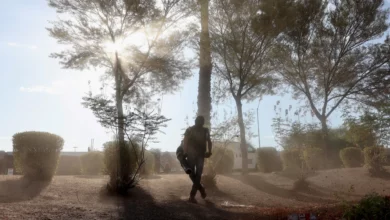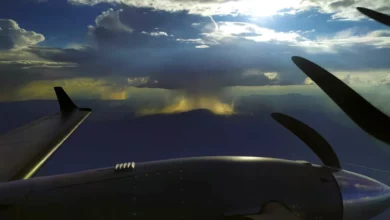
From afar, the Rhone glacier looks pristine, but on closer inspection the surface is covered with white blankets to slow the melting of the rapidly retreating ice.
The dusty, white fleece covers stretch out over a huge area near the glacier's edge, some in rumpled piles alongside sand, rocks, a few wooden planks and a ladder on its side.
With a red and white Swiss flag providing the only dash of color, they look like tents in a vast deserted refugee camp, out of place in the Alpine setting.
But hiding underneath the blankets is a Swiss tourist attraction: a long and winding ice grotto with glistening blue walls and a leaky ceiling that has been carved into the ice here each year since 1870.
"For the past eight years, they have had to cover the ice cave with these blankets to reduce the ice melt," said David Volken, a glaciologist working with the Swiss environment ministry, poking at a piece of cloth lying near the path that leads to the cave's opening.
The blankets, he said, reduce the ice melt by as much as 70 percent, explaining why the covered cave towers far above the nearby center of the glacier tongue, which slopes lazily into a pine-green lake.
But while the blankets help slow the melting and allow the ice grotto to remain open through the hot summer, they are a very temporary fix.
'Dying mountain'
"It will slow things down for a year or two, but one day they will have to take away the blankets because the ice underneath will be gone," said Jean-Pierre Guignard, a 76-year-old tourist from the Swiss town of Lausanne.
He recalled seeing the glacier for the first time in 1955. The tongue then reached far down the steep mountainside, which today is hammered by a roaring waterfall pouring from the glacier lake and marking the starting point of Europe's mighty Rhone river.
"It has been heartbreaking to see the glacier shrink, and today it is really painful to see it covered in blankets, to see this vain battle to save a dying mountain," he told AFP.
A full 1,400 meters (4,600 feet) down the mountain side, near the small village of Gletch, a wooden post signals where the glacier once ended back in 1856.
Since then, the Rhone glacier has lost around 350 meters in ice thickness — around 40 meters in the past decade alone.
It is not the only Alpine glacier feeling the heat. Studies show that around two-thirds of the ice volume in the Alps has vanished since 1850.
"The Rhone glacier is quite typical of what is happening in the Alps," said Matthias Huss, a glaciologist at Fribourg University. "We are seeing less new ice created in higher altitudes even as the lower parts of the glaciers are melting at an accelerated pace."
World leaders will gather in Paris later this year to try to agree to a plan to restrict the global warming blamed for the mass glacial melt and other dangerous shifts in the environment.
The overarching goal is to limit average warming to 2 degrees Celsius (3.6 degrees Fahrenheit) over pre-Industrial Revolution levels.
But for the Alpine glaciers, it is likely already too late since the Alps, like the Arctic and the Antarctic Peninsula, are considered hotspots that are warming at least twice as quickly as the global average.
Wearing a t-shirt under the glare of the sun, Volken said the Rhone glacier loses between 10 and 12 cm (up to eight inches) of ice thickness on a hot day.
And the new lake that has formed at the edge of the glacier, as well the darkening of the ice — a result of impurities mixing in as it melts and freezes again — only speed up the process since they help the glacier absorb more of the sun's radiation.
Blankets not enough
"In the last three weeks, the glacier has melted back 6 meters," said Volken, pointing to the rocky surface recently covered in ice.
Each year, the glacier loses between 5 and 7 meters in ice thickness, and within the next decade it is expected to lose half of its current volume.
"By the end of the century, only about 10 percent of the current ice volume will remain," Volken said.
Unlike the melting in the Antarctic and the Greenland ice caps, that of the Alpine glaciers will have little impact on global sea-level rise.
If all of the region's glaciers melted, this would add only about 0.3 millimetres to ocean levels, Huss said. But he quickly added that the local impact will be dramatic.
The Alps function as a water tower that stores water, releasing it when it is most needed — in the hot and dry summer months.
As the ice melt accelerates, Alpine glacier-fed rivers that stretch across Europe, like the Rhone, will initially see higher water levels and more flooding, though by the middle of the century water levels will decline dramatically, Volken said.
Standing near the edge of the Rhone glacier with its odd blankets Christine Ouedraogo, a 37-year-old tourist from Burkina Faso, listened to the rapid dripping of the dissolving ice.
"It's beautiful, but it is such a shame that it is melting away," she said sadly.
"I don't think those blankets will be enough."




